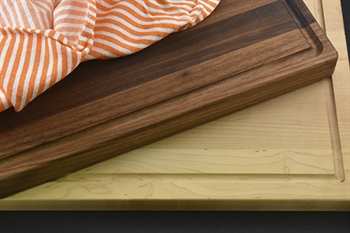
When you set out to buy butcher block boards, the huge variety out there can surely be a little daunting. Luckily the varieties of high-quality hardwood butcher blocks can be divided into 3 main groups according to their surfaces. These are flat grain butcher blocks, end grain butcher blocks and edge grain butcher blocks.
Each of these groups have a different impact on the appearance of your butcher block board and on the way they affect your knives. So, let’s understand their differences in detail. And learn about their benefits so you know exactly which one suits your needs best.
When wood is cut at a right angle to the tree’s growth line, it is called flat grain. Flat grain lumber has two sides:
1 - The part of lumber that is closest to the exterior layer of the tree is called the bark side.
2 - The side closest to the centre of the tree is referred to as the pith side.
Flat grain boards are beautiful. If you’re looking to add a beautiful piece of art to your kitchen space that doubles as a sturdy and versatile butcher block, then we’d recommend going for flat grain boards.
An end grain butcher block board is made by putting many smaller pieces of hardwood in a vertical position and grafting them together. The rings you see when you cut a tree, are end grain.
The surface of end grain exposed to the knife when cutting is a fibrous material. When the knife slides on it, the fibres microscopically separate. This means that using end grain butcher blocks keep your knives sharper for longer. As a result of the fibres separating only slightly, knife marks don’t show on the board quickly either. Thus, end grain butcher blocks are easy to maintain and last longer. They are also less prone to cross-contamination.
Edge grain butcher blocks are made by placing together strips of hardwood side-by-side and grafting them together. Thus, the edge of each strip of wood forms the cutting surface.
With the strips of hardwoods like maple and cherry showing on the surface, edge grain butcher block boards have an appealing look. These do, however, require more maintenance as compared to the other two types of butcher block boards. Regular cleanliness and oiling help to make them last longer.
When it comes to deciding on one kind out of all the varieties available, it’s hard to single out the best or worst. What works for one person, might not do for others. We at Butcher Block Boards would recommend making note of your requirements and then weighing the pros and cons of each category. Whichever type you choose, be sure to pay attention to routine maintenance, to make your board last longer. Visit our website to check out our variety of high-quality butcher blocks today!